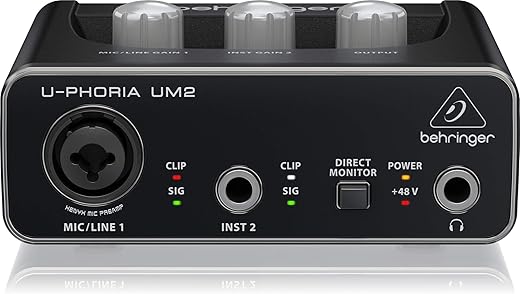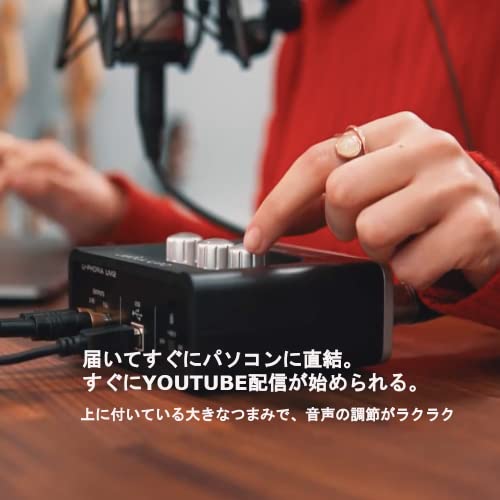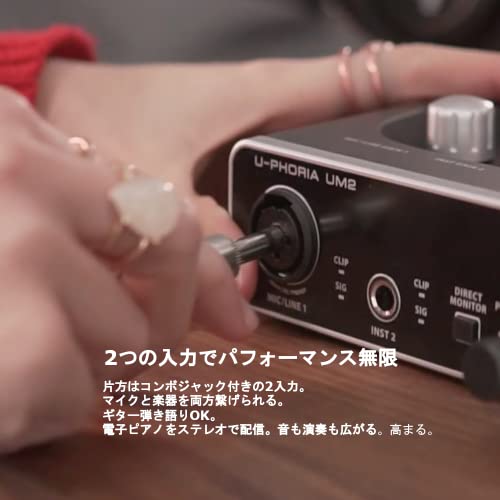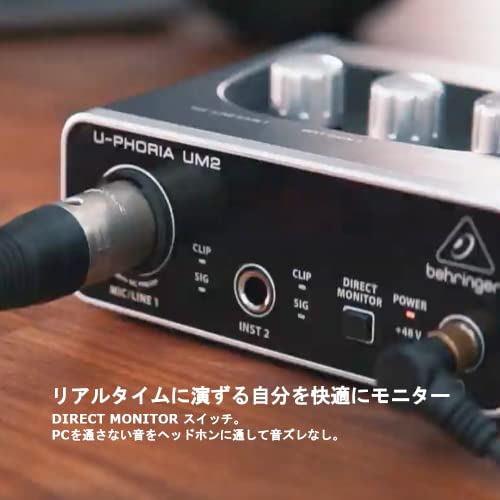
Behringer U-Phoria UM2 USB Audio Interface Price comparison
Behringer U-Phoria UM2 USB Audio Interface Price History
Behringer U-Phoria UM2 USB Audio Interface Description
Behringer U-Phoria UM2 USB Audio Interface: Exceptional Sound Made Easy
The Behringer U-Phoria UM2 USB Audio Interface is the perfect solution for musicians, podcasters, and content creators seeking to elevate their audio quality. Designed for seamless connectivity and high-quality sound, the UM2 combines functionality with user-friendly features. Whether you’re using a laptop or a personal computer, this audio interface delivers professional results without breaking the bank. Discover the best price, reviews, and more below!
Why Choose the Behringer U-Phoria UM2?
Here’s why the Behringer U-Phoria UM2 stands out:
- Compact Design: Weighing just 9.2 ounces, the UM2 is portable and ideal for mobile setups.
- Versatile Connectivity: Features multiple input options including 1x XLR/TRS, 1x 1/4″, and 2x RCA, making it compatible with various devices.
- High-Resolution Audio: With a 48 kHz sample rate, your recordings will capture intricate details in sound.
- Easy Setup: Plug-and-play design ensures you can get started quickly without a complicated installation process.
- Bundled Software: Comes with Tracktion 4, giving you access to a powerful DAW right out of the box.
Comparative Pricing from Different Suppliers
The price of the Behringer U-Phoria UM2 varies significantly across multiple retailers. As of now, you can find it for:
- Amazon: $$[insert latest price]$ – Known for fast shipping, offers great deals.
- Best Buy: $$[insert latest price]$ – Offers in-store pickup options.
- Musician’s Friend: $$[insert latest price]$ – Frequently features discounts for musicians.
By comparing prices across these suppliers, you can ensure you’re getting the best deal possible on the Behringer U-Phoria UM2.
Insights from the 6-Month Price History
The 6-month price history chart for the Behringer U-Phoria UM2 shows noticeable trends. Over the past few months:
- The price has fluctuated between $[insert high]$ and $[insert low]$ depending on sales and promotions.
- Recent drops in price indicate a potential trend for buyers to take advantage of while the price remains low.
- Watching the price history can help you make a timing decision on when to purchase.
Customer Reviews: The Good and the Bad
Customer feedback on the Behringer U-Phoria UM2 reveals a mix of praise and critique:
- Positive Aspects:
- Many users commend the audio clarity and quality, especially in vocal recordings.
- Easy to set up and use, making it a perfect choice for beginners.
- Compact design allows for easy storage and portability.
- Noted Drawbacks:
- Some users reported occasional driver issues, particularly with older operating systems.
- Limited input channels might not suit larger live setups.
Overall, customer reviews commend the Behringer U-Phoria UM2 as a fantastic entry-level audio interface, especially for those focused on achieving high-quality recordings on a budget.
Dive Deeper with Unboxing and Review Videos
If you’re considering the Behringer U-Phoria UM2, check out the detailed unboxing and review videos available online. These visual engagements provide an in-depth look at the product. They often highlight features you may not have considered and showcase the setup process. YouTube offers numerous creators dedicated to audio gear who can guide you through the UM2’s capabilities comprehensively.
Final Thoughts
In conclusion, the Behringer U-Phoria UM2 USB Audio Interface is an exceptional choice for anyone looking to enhance their audio recording experience. With its user-friendly design, versatile connectivity options, and high-resolution audio quality, it meets the needs of both beginners and experienced creators. Don’t miss the chance to get this innovative audio tool at the best price!
Compare prices now!
Behringer U-Phoria UM2 USB Audio Interface Specification
Specification: Behringer U-Phoria UM2 USB Audio Interface
|
Behringer U-Phoria UM2 USB Audio Interface Reviews (7)
7 reviews for Behringer U-Phoria UM2 USB Audio Interface
Only logged in customers who have purchased this product may leave a review.












Mr siju –
Good product
Christopher L. Barber –
So far I can’t complain. The device does everything it’s supposed to do that I have tested so far. That’s everything except MIDI. Looking at the aggregate reviews of this product and its siblings on Amazon you will see a really mixed bag of results including as much as 12% one star. That can be a bad sign, but not necessarily. Looking at the reviews of this exact product on another web site that sells musical and pro-audio exclusively the aggregate rating there is higher with a near-zero fraction of very low ratings. That fact combined with the low cost of the product made it worth taking a chance on. At this price point, compared with what I will have to pay for a different very high-end product that pretty much takes out all the risk makes this Behringer product “trial” essentially disposable. For me, that’s pretty much how I have to look at the costs of these things. That won’t be true for everyone.
So my experience with this so far:
Set it up with some audio sources to the inputs, verified they were routing through to the headphone output, made sure I understood how to use the controls associated with this basic mode of operation. All good. Tested it with a CD player, a guitar (through an effects box), and a microphone. Phantom power is good, but it’s all-or-nothing for all four inputs so watch out for that if you are using mixed microphones.
Downloaded the UMC driver from Behringer and installed it. No problem, no conflicts. This is on Windows 7. Make sure you’re up to date on windows updates, and read the release notes for the driver thoroughly. There are a couple of things that will break the driver due to missing updates or non-default group policy. It’s all spelled out in the release notes. This alone probably accounts for half of the “didn’t work with my computer” problems.
After installing the drivers I connected the device to the computer for the first time. It was recognized and appeared in the driver’s on-screen device list/manager window. This is a nice feature of the driver. You can’t do a ton of stuff with it but at least you can see what’s connected and you can do some basic configuration.
Next thing I did was start my DAW. I’m using the current (free) version of Cake Walk by BandLab. I figured it would see the new audio device and ask me if I wanted to switch my input and output assignments to this device. What it actually did was blue screen the computer! And it was not a fluke. Totally repeatable, as long as the 404’s usb cable was plugged in. But it started with no problem with the 404 disconnected. Once Cake Walk was running I connected the usb from the 404 again and everything was ok. Cake walk recognized the audio devices and I switched my inputs and outputs over to it accordingly. With that step done, Cake Walk now opens and closes and opens again while the 404 is connected with no problems. I would have to say it’s a toss-up between blaming the UMC driver or Cake Walk for this initial problem. It doesn’t matter, it was just a transient.
So now my audio is going in and coming out of the computer. I’m really just learning Cake Walk so I’m not doing a lot of complex tests at this point. I recorded some audio off the input from the 404 and played it back through the 404 and that all worked. Audio quality is fine. I’m not an audiophile and I’m not using this for professional recording and it suits my needs for now.
A couple of negatives:
Phantom power is not individually selectable per input. Everyone will complain about this.
The headphone / monitor output on the front panel can only listen to two of the four output channels (audio coming from the computer) at once. A pushbutton on the front panel selects between outputs 1+2, or 3+4. You cannot get all four at once, and this is quite a limitation if you’re not using a mixer.
Overall I’m totally happy with this so far. I have not experienced any of the complaints that I have read in other reviews. It will be interesting to see if it holds up over time.
Martin C. –
I’ve been recording music and sound both professionally and for fun since the mid-90’s. I’ve been fortunate enough to get to use a wide variety of equipment at all levels, from cheap junk to top pro quality. My home desktop recording setup has centered around an M-Audio Delta1010 card for many years. In studios, I’ve used a variety of things, from Digidesign, RMC, Apogee, etc… I needed a simple and cheap USB interface to use with an old beater laptop for some mobile recording. After much research, I nabbed a Behringer UMC404HD. The price was cheap enough to be worth the gamble; I’ve used Behringer things a few times in the past, but never an interface, and was worried it might be too junky to be usable. But seeing that these are perpetually out of stock at most places, I figured it would be easy enough to flip if it ended up being a lemon. Thankfully, I won’t even need to worry about that, because this one is a winner! Best $99 I’ve spent on anything in a long time.
Sound quality is great. I’d say the quality of the conversion beats my M-Audio card (which was originally at least 6x the price!). I’m going to chalk this up to improvements in technology over the years, and it really makes the Delta show its age. A nice clear sound, not lacking in body, and doesn’t have any of the harshness I’ve encountered with other Behringer products of the past. I’m not going to say it’s “warm” sounding at all, but it really doesn’t need to be, honestly. It’s just a solid clear sound with a minimum of any noticeable hype or color. Behringer’s parent company recently bought Midas, and the UMC404 claims to have the same mic preamps as used in the high end Midas consoles. Which model of console is anyone’s guess, and it’s really more just an excuse to stick the name on there to play off the reputation of the name (though, Midas is a big name in live FOH consoles, not really anything to do with recording consoles). But whatever, the mic preamps do sound good. Noise isn’t too bad – recording piano with some dynamic mics didn’t get any bad noise issues. It will get a bit hissy if you have to max the gain out, but there are few situations where I see that happening, and if you really need lowest noise, you can always use a nicer external preamp and patch into the line inputs. The inserts included on each input is a nice touch! You can easily patch a compressor after the mic input – which is good news for tracking vocals. This is an extremely helpful feature that most other interfaces neglect.
One complaint about the mic preamps: they don’t work well with low-output ribbon mics. I tried it with my Cascade Fat Head II and it was a no-go. Not enough clean gain available. Had to max it out to get any signal and at that point the noise was too much. Ribbon users would need something like a Cloud Lifter or other external preamp to be able to use them with the UMC. Too bad, but that’s really not a huge letdown considering the price and how well the unit performs otherwise.
Control panel for the drivers is very spartan, but it does enough to tell you what’s going on and make a few adjustments. People like me who are used to the luxury of an onboard DSP zero latency monitor mixer (like the Delta has) will be a little disappointed by the lack of monitor adjustment with the simple analog input monitoring on the box itself, but it’s still work-able, just a bit unusual to lack a separate control for monitor mixing. But considering the price and general sound quality, this isn’t really a complaint.
As far as how well it plays with software, I’ve tried this with Adobe Audition, Reaper, and Tracktion. It works just fine doing multitrack using the ASIO drivers in Reaper and Tracktion, but it did NOT work well with Audition at all. Attempting to use the ASIO drivers to do a multitrack recording in Audition caused Audition to crash. Multitracking in Audition doesn’t seem to work at all with this, even when switching to the MME or WASAPI drivers. I’m blaming this on Audition because Adobe sucks. Tracktion was billed as “included” software, but it wasn’t actually in the box with it, and when I registered the product with Behringer to get my “free” download code, I have yet to get any reply from them. There’s a free version of Tracktion available and that’s probably what they’re talking about. Behringer pulled this crap before by including the freeware Audacity with interfaces and billing it as some great deal of included software (and Audacity sucks, BTW). Tried messing with Tracktion a bit, but really not a fan of the workflow. It’s quick and easy, but it’s too stripped and just not an interface I find comfortable. Reaper gave the best results for multitracking on the laptop, and then I used Audition for editing/mastering the final mix. My main software on desktop is Samplitude Pro X, but I haven’t plugged the Behringer into my desktop yet. The laptop is running Win10, so good news for Win10 users that the drivers seem to work fine with it.
Haven’t tested the MIDI yet, and therefore haven’t used any realtime softsynths with it, so I can’t make any judgment about the latency. The control panel gives you some control over this, so I’m sure I could probably get it to where it feels good for realtime synth. But as this is being used almost exclusively for recording, low latency is really not on my list of needs.
Time will tell about the long-term reliability of a $99 interface with this much packed into it, but overall construction seems solid and I’ve had no feelings about it being too delicate to carry around in my backpack. Should hold up well to regular mobile use.
Giving something like this 5 stars seems excessive, because there’s certainly better out there. But at this price? Not even close! In the very crowded world of sub-$200 audio interfaces, I will put the UMC404HD up there as a clear winner.
Cem –
fiyatina göre başlangıç seviyesi icin güzel bir cihaz
Ricardo –
Me gusto en general la interfaz, funciona bien conforme a lo esperado. Capta muy bien las señales de entrada, con mucha claridad y sin ruido. Tiene un nivel de ruido de fondo (NSR) que solo se nota cuando subes mucho el nivel de amplificación de la señal de entrada, o se usan cables no balanceados. (Lo noté mas cuando probé con unos cables no balanceados) Pero en general no es apreciable el ruido, a menos que se quiera grabar a super calidad de audio.
Considerando el precio y el nivel de la interfaz, a mi me resulta adecuado, suficiente y me funciona bien. No hay problema. La salida a las bocinas y a los audifonos para monitoreo y los controles de volumen, funcionan perfecto.
La instalación del driver es sencilla para Windows 10 y activa el driver UMC ASIO con un nivel de sampling de 48,000 Hz y muy baja latencia de 12-13 ms. El driver de audio me jaló muy bien con el DAW de Ableton Live 11 y Reason 11. Lo detectó sin problemas. (Noté que a veces cuando la compu entra en suspensión, como que se suspende tambien el driver USB. No se si es un problema de Windows 10, de mi compu o quizá del driver).
Ricardo –
Superb Quality
Marcus Vinicius Cardoso Sa Barreto –
Voce que não tem $$ para uma interface de ponta, essa atende perfeitamente para um home Studio.